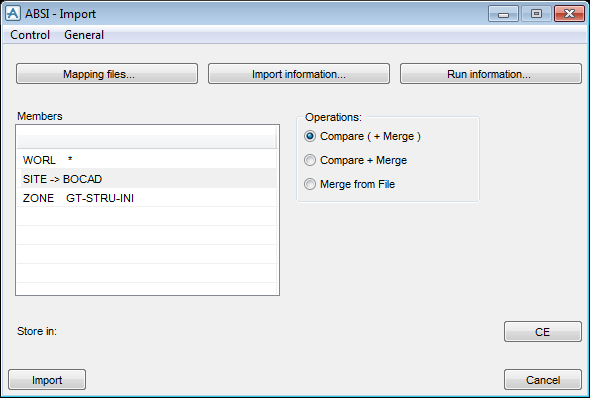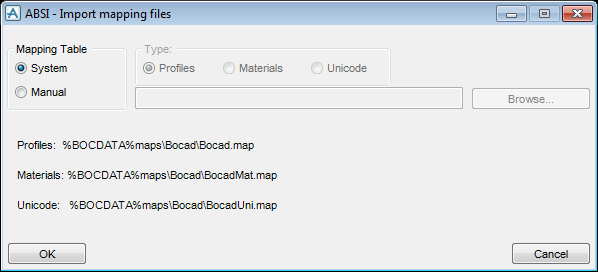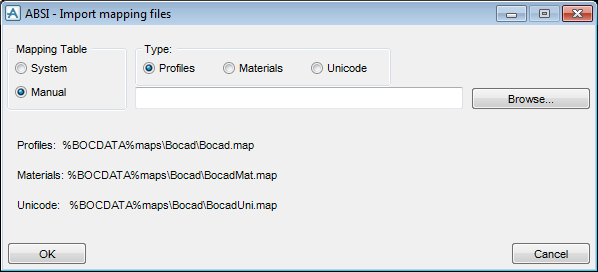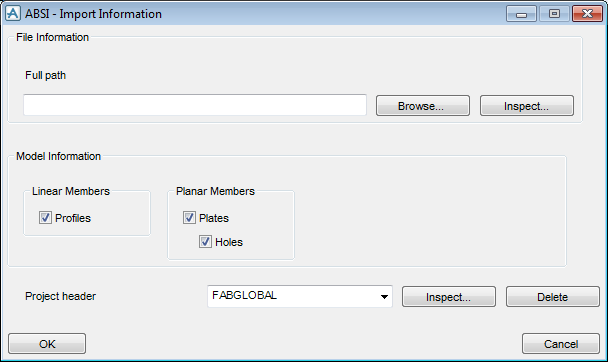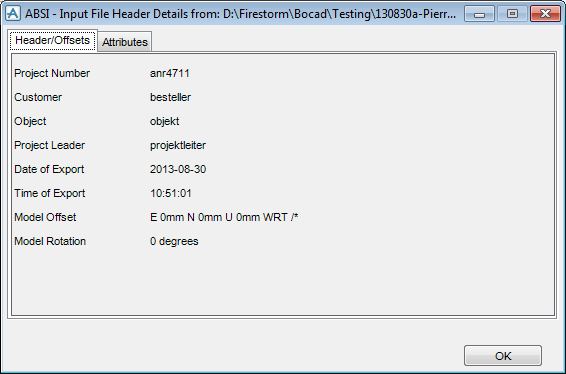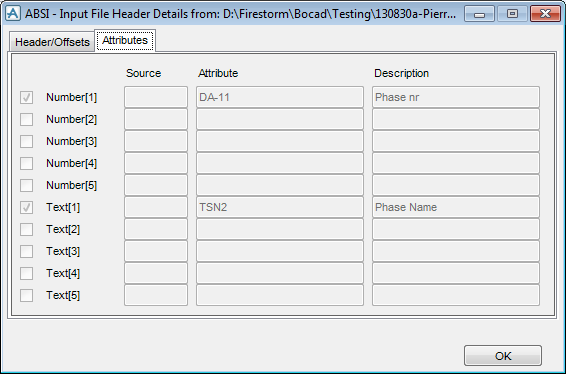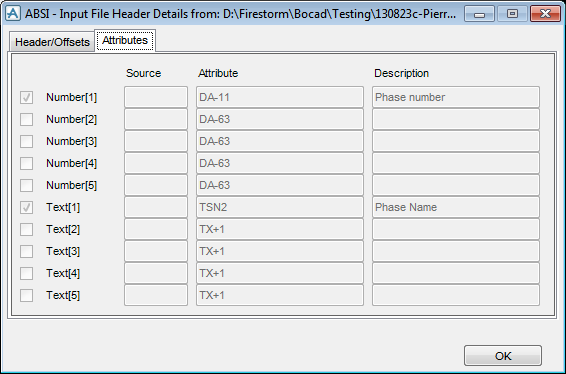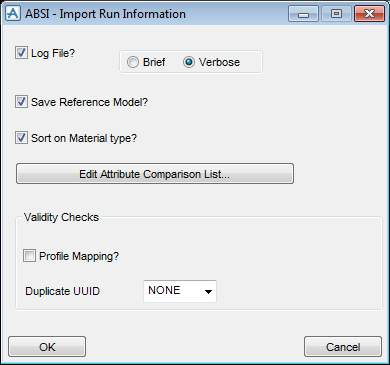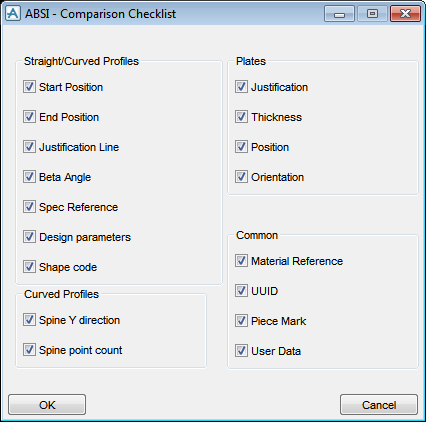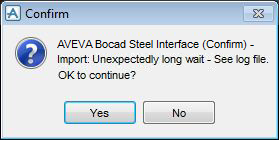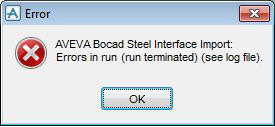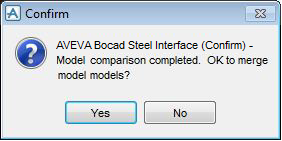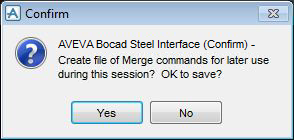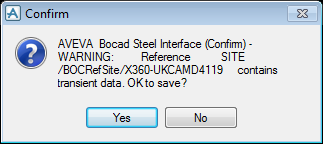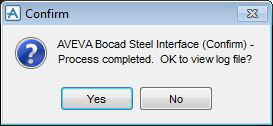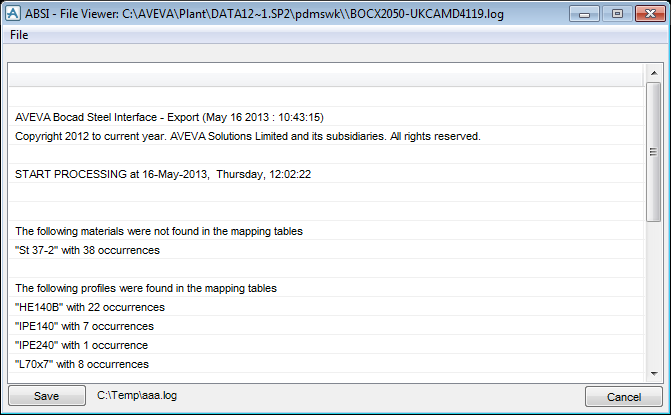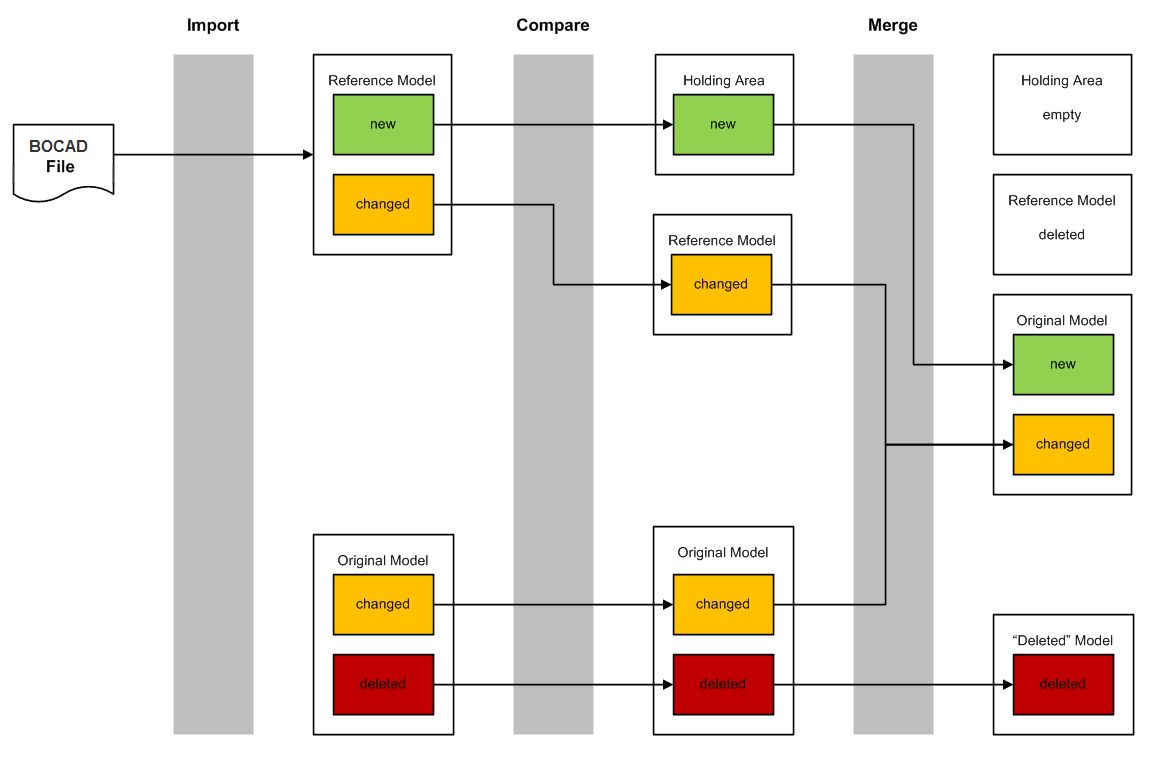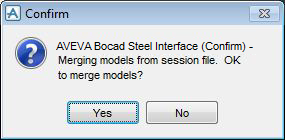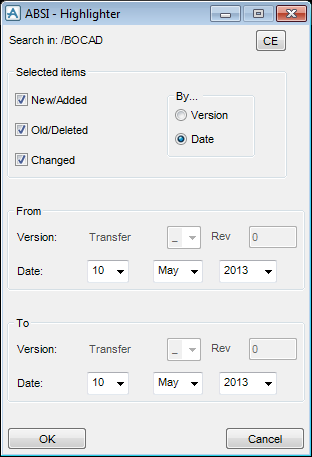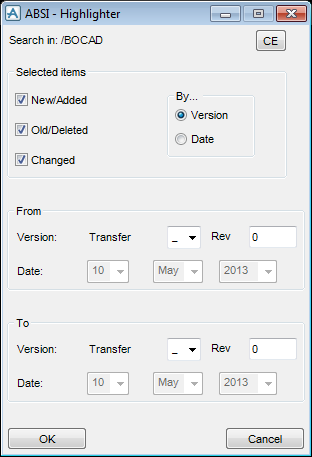Bocad Steel Interface
Bocad Steel Interface : Export/Import : Import from AVEVA Bocad Steel
To import a steel structure from an AVEVA Bocad Steel Interface file, on the TOOLS tab, in the Import group, select AVEVA Bocad Steel to display the ABSI - Import window.
A Warning window may be displayed stating mapping files are not found, this means local versions have not been set up, use the default set provided with the product.
Click Mapping files to display the ABSI - Import mapping files window populated with information about the mapping files that will be used in the Import process.
The interface requires at least two external mapping tables to enable the interface to check that the base product can accept the data. It also may use the internal Profile Orientation and/or the Unicode mapping table if necessary. The mapping tables are for the Profiles, Materials, Unicode text string and for mapping the Profile orientations between the AVEVA Bocad Steel Interface file and the AVEVA steel catalogue. The section Customise explains how you can arrange these files on the file system and what format they are to be. The interface also needs to know where the external mapping files are located on your computer network. For this internal mapping tables are required. Refer to Customise which explains how you can configure the interface to let it know where all the files are located.
|
Note:
|
Do not be concerned that the path name may be truncated by the insertion of the ellipsis (…): it is modified only for display purposes on the window.
|
The system also checks that these files are compatible with AVEVA Bocad Steel by checking only the identification line at the top of each mapping table. Refer to Internal Mapping Files for details about the format of these mapping files.
The two main options are Auto and Manual which are activated by selecting the appropriate radio button on the left hand side of the Import mapping files window.
The Auto option causes the interface to select automatically the mapping tables for AVEVA Bocad Steel, according to the system configuration files. When you come to execute the Import process, the Auto flag will cause the correct mapping files to be used based on the Input file header.
The Manual option activates other buttons, which are initially greyed out for the System option. Selecting this option changes the window to be similar to below.
You can select the file type using the Profiles, Materials or Unicode radio buttons above the text data entry field and enter the full path name of the file in the data entry area. You can also include system environment variables in the path name as long as they are in the proper base product format, for example: %ENVVAR% being the representation of the ENVVAR environment variable.
You can choose by hand which mapping file to use by either entering its name in the text data entry field, or by using the Browse option to bring up a File Browser. Use this browser to search for the relevant mapping file.
Once all the correct data has been entered on the Import mapping files window, click OK and it updates the interface variables. Click Cancel to close the window, leaving the original interface variables unchanged.
From the Import window, click Import Information to display the Import Information window which is populated with information about the import process.
You either types the full folder path name of the input file, or clicks Browse to bring up a File Browser. The interface tests to see if the file exists and if it does not you will be warned. As well as testing for the existence of the file, it is also tested for being a valid file by inspection of its header details.
You can view the header information of the chosen input file, click Inspect, to display the Input File Header Details from window with which you can determine whether the file is the correct one to Import.
From the Attributes page, you can see what user data is being transferred from AVEVA Bocad Steel.
Use the check boxes on the Import Information window, to select whether to import Linear Members and/or Plates or Holes.
Once all the correct data has been entered on the Import Information window, click OK and the interface variables updates. Click Cancel to close the window, leaving the original interface variables unchanged.
From the Import window, click Run Information to display the Import Run Information window. The window allows you to view the Log File after the import process is complete by clicking the Log File? check box.
Click either the Brief or Verbose radio buttons you can choose which format messages are displayed, the detail of these messages is given elsewhere.
As part of the Import process a reference model is constructed against which comparisons will be made. Save Reference Model allows you to keep this. Otherwise it will be deleted on completion of the Import process.
After the Import merging process has been performed, you can sort all new items into FRMW (Framework) elements according to their Material type. This option is selected by clicking the Sort on Material Type option.
During the Import process, comparisons are made for Linear Members and Plates between the existing model data and the imported model data. The default system configuration compares all the relevant data transferred in the file between the models. However, you can select which attributes may be ignored by the comparison process by clicking Edit Attribute Comparison List to display the Comparison Checklist window.
Profile Mapping? enables you to see if the incoming Linear Member Profile specifications will be successfully mapped between systems. This is a relatively fast transaction as the file is just passed through the external program without any subsequent import or comparison in the base product. You will then be able to see the log file produced and take appropriate action.
There is a risk in either package that entity UUIDs may be duplicated. The Duplicate UUID selector gadget enables you to check for duplicate UUIDs in the incoming model. There are three options: NONE, NEW and GLOBAL. NONE deactivates the gadget and no checks are made. The import process just goes through unhindered. The NEW option allows you to check only the new imported items for duplicate UUIDs, while the GLOBAL option enables you to search all the available databases for duplicate UUIDs. Obviously these searches may involve a certain amount of time, but for the sake of validity, they would be worth using.
Once all the correct data has been entered on the Run Information window, click OK and the interface variables updates. Click Cancel to close the window, leaving the original interface variables unchanged
On the Import window the Members list can be used to navigate around the database hierarchy.
You must state where the Imported model is to be located. This must be a SITE, ZONE or STRU element. Using the Members list, navigate round the database to the correct storage location and click Store in: CE. The window text indicates where the Imported model will reside. If there is not enough space on the window, the SITE's reference number is output rather than its name.
The Import process is essentially a three phase operation. First a reference model is built which is then compared with the original model identified during the Store in: CE operation. Then, if required, the changes, additions and deletions encountered in the comparison phase are transferred to the actual model. Thus, using the Operations toggles, you can control how the Import process is to proceed.
|
Note:
|
These options may be completely overridden if you want to perform a validity check as on the Run Information window.
|
|
Imports the model and compare the reference model with the location chosen to be the storage area. At this point you will be asked whether to merge the models. Click Yes to continue with the merge process and complete the Import.
|
|
Import executes the Import process. As it proceeds you are kept informed of the progress.
The Control drop-down menu has four options; Re-initialise, Configure, Map Convertor and Exit. Changing any mapping files or any other variables:
|
•
|
Re-initialise reloads files to save you having to rebuild the whole user interface from scratch
|
|
•
|
Configure enables you to define run parameters, model parameters, display colours and environment parameters. Refer to System Configuration for further information
|
|
•
|
Map Convertor starts the tool that helps you to rebuild Profile mapping files.
|
|
•
|
Exit removes all forms and menus and global variables associated with the interface.
|
The General drop-down menu has two options, Highlight and Clear ABSI History. Highlight displays the Highlighter window enabling you to identify new, changed and deleted items in the model. This has more relevance to the Import process, refer to Highlighting Changes in the Design for further information. Clear ABSI History enables one to clear the import/export history on the current element and all elements below that have date and time UDAs that are relevant to the AVEVA Bocad Steel Interface.
After clicking OK the fields in the window are checked for validity:
Click Yes and the interface will wait for another period of time. Click No causes the interface to stop where it is. Finally the system will indicate its completion, whether successful or not. This completion message should be read in conjunction with the log file, if any errors are indicated.
Click Yes and the interface continues with the Merge process.
Click No and the Import process skips the Merging, but you are then given a chance to store the Merging commands in a file for use later on only in the current base product session. You cannot use a file from a previous session as the Import data may be incorrect.
You can save the Merge command file and then be prompted whether to see the Import log file. This Merge command file may then be used in the Merge from File option on the Import window. This latter option needs the reference model from this run to be kept. Therefore, you do not have the option below.
If you have merged the models, they will then be asked if they want to keep the reference model, verifying the option selected on the Run Information window.
Finally, you are asked whether to view the log file, if they have chosen that option on the Run Information window.
If you want to inspect the log file, they can then save it with the File > Save as option in the File Viewer window which will bring up a File Browser, or by clicking Save as to the suggested filename. If the file exists, you will be asked whether they want to overwrite it. The log file window can then be closed by clicking Cancel.
If you have chosen Brief mode on the Run Information window for displaying the log file, the window displaying the log file will filter out all Warning messages, leaving only the Error messages. To save the log file, however, all messages will be retained in the file.
|
•
|
|
•
|
The Comparison process allows any potential changes, additions and deletions to the original model to be detected and shown in a 3D Volume View window, if there is one present and if the items are in the current Drawlist.
As for both Linear Members and Plates you can select which attributes are significant for Comparison. This is performed using the Comparison Checklist window which is a child of the Import Run Information window. By default, all the attributes transferred through the file are compared.
The log file messages recording any differences are of two formats: in Brief mode the results are presented on one line; in Verbose mode you are told what the old value was and the new value is so that they can see how the model has been changed. Refer to Brief Format for details about the brief log file format.
The log file messages recording any differences are of two formats: in Brief mode the results are presented on one line; in Verbose mode you are told what the old value was and the new value is so that they can see how the model has been changed. Refer to Brief Format for details about the brief log file format.
Refer to diagram in Comparison and Merging Processes illustrating the route by which information is transferred from the Import, through the Comparison and on to the Merging processes.
The interface manages the Comparison and Merging of imported models so that other important engineering data is not lost or overwritten. However, other data, including connectivity may be lost.
You can separate the Comparison and Merging processes, so that they are able to view the log file in between operations. If you choose the Merge from File option on the main Import window, the Comparison process is deemed to have been completed and so all that remains to be done is the actual Merging. This is why the reference model for the current session must still be available, you will be prompted for confirmation.
After the main model Merging has been completed, if you have chosen the Sort on Material Type option on the Import window, any new items will be sorted into FRMW groups according to their material type as specified by the :FABMGRADE attribute.
For example, a new STRU may be created with the name of /FAB-NEW-DEMO-SYSTEM/A.1 under the container element as specified in the Store in: field on the Import window. The components of this name are as follows:
|
/FAB-
|
|
For example, a new STRU may be created with the name of /FAB-OLD-DEMO-SYSTEM/A.1 under the special SITE /FAB-OLD-DEMO-SYSTEM. The components of this name are as follows:
|
/FAB-
|
|
As has been described in Comparison and Merging Processes there are two validation checks you can perform prior to the full import and merging of models.
The first option is for profile mapping. The Profile Mapping? Option on the Run Information window turns this on. The Import process initialises normally and calls the external program to process the incoming file. In so doing it checks for a complete mapping of the profiles in the mapping tables. A log file is produced. No further Import actions are undertaken with this option.
The options for this check are NEW and GLOBAL. NONE turns the facility off. NEW checks among all this run's imported members contained in the reference model for duplicate UUIDs, while GLOBAL checks the whole structural database, both imported and existing elements. These can be quite slow options as the reference model must be created and compared anyway.
As this option also calls the external program which checks the mapping of profile names between systems, you will see that the log file may also list any problems with the mapping tables. So this option is actually a combination of this and the previously mentioned validity checking option. For a sample log file, refer to Sample Validity Check Log File for further information.
You can display a Highlighter window from either the Import or Export windows by the General > Highlight menu bar option.
The window allows you to identify in a graphical window whatever they want, either according to Import date, or by Transfer/Revision number combinations. The Select by toggle switches the window into the appropriate mode. Both these options work from the start element selected and will indicate only those items that are in the drawlist.
In the Selected items box, you can select any combination of Added, Changed, or Deleted Items for identification, according to the date range described below.
By selecting the inclusive dates defining the limits of the range using the From and To date selector gadgets you can locate on the screen those items in the current drawlist which have been changed, added or deleted.
The functionality available to select changed, deleted or added items is identical to that for highlight by import date, refer to Highlighting by Import Date for further information.
By selecting the versions defining the limits of the range using the From and To version selector gadgets you can identify on the screen those items in the current drawlist which have been changed, added or deleted.

